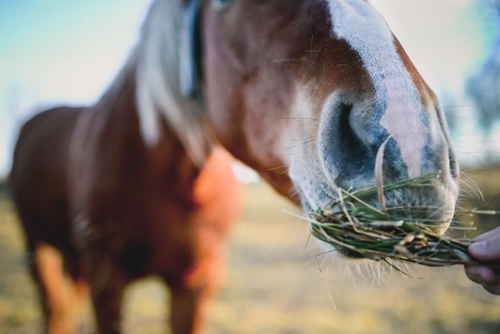Horses evolved as continuous grazers, which puts their preferred diet in conflict with their domesticated lifestyle. Keeping a healthy, adult horse well fed and supplied with the right nutrients is a task in and of itself, but horses with special circumstances require extra scrutiny. Youth, maturity and weight management are all reasons to monitor a horse’s diet.
“Overfeeding yearlings leads to developmental orthopedic disease.”
Feeding a young horse
Horses need a diet that supports natural, healthy development throughout their first few years, not one that seeks to add as much mass as possible. Using diet to force a horse to grow faster creates a discrepancy between the size of the horse’s bones and their density. According to the University of Minnesota, yearlings are between 90 to 95 percent of their maximum height, but their bones only have about 75 percent of their total mineral content. As a result, overfeeding often leads to developmental orthopedic disease.
To support proper bone development, young horses need the right ratio of calcium to phosphorous. If the balance is skewed in either direction, your horse will have trouble absorbing all the necessary nutrients. The correct calcium-to-phosphorous ratio ranges from 1:1 to 3:1. In addition, young horses aren’t yet fully able to metabolize forage into energy, so they need more sugar than elders. Still, horses that have recently weaned should eat a diet of at least 30 percent forage.
Although a mixture of forage and grains provides major minerals, it lacks certain trace nutrients. A veterinarian will usually suggest daily equine supplements like Finish Line’s Ultra Fire. Keep an eye on your horse’s appearance as you craft its diet. A healthy yearling has visible ribs with a slight amount of fat covering the top half.
The mature horse’s diet
Mature horses often have trouble absorbing all the nutrients they need. As the University of Georgia detailed, such issues could stem from dental problems, prior damage from parasites and decreased gastrointestinal functions. This means the horse needs feed that is easily digestible and high in energy, such as beet pulp. You can also use feeds containing grains that have been cracked, rolled, crimped or steam flaked, as breaking the seed coat makes the grain easier to digest.
Adding fat also aids an elderly horse’s digestion, and many feeds come with fat already blended in. However, these equines need less food overall to maintain a healthy condition. If you choose a feed with extra fat, make sure to increase the amount of protein, vitamins and other nutrients your horse receives as well.
Before adding fat and equine supplements, have your veterinarian conduct a blood analysis to determine your horse’s liver and kidney health. A poorly functioning liver can’t support additional fat, and horses with kidney disease can’t tolerate feeds high in calcium or protein such as beet pulp or alfalfa.
“A diet of hay and equine supplements supports healthy weight loss.”
Diet and exercise for weight management
The best way to help an obese horse lose weight is to provide plenty of exercise and closely monitor its caloric intake, according to Rood and Riddle Equine Hospital. This is true regardless of whether the horse is simply overweight or if it suffers from a condition like Equine Metabolic Syndrome. A diet of hay and equine supplements is usually appropriate, although a veterinarian will help you construct the right mixture. Generally, an obese horse should eat up to 2 percent of its body weight in hay.
Because grass has a high sugar content, horses with EMS should have minimal access to pasture. Instead, let them exercise for at least 20 minutes each day. In addition, studies suggest certain medications and supplements treat insulin sensitivity. One group of researchers, according to Rood and Riddle, found omega-3 fatty acids support healthy blood insulin levels in humans. They expect omega-3s will have a similar effect in horses.
Your horse needs small feedings multiple times a day, regardless of its specific dietary requirements. Take each scheduled feeding as a chance to observe its condition.









